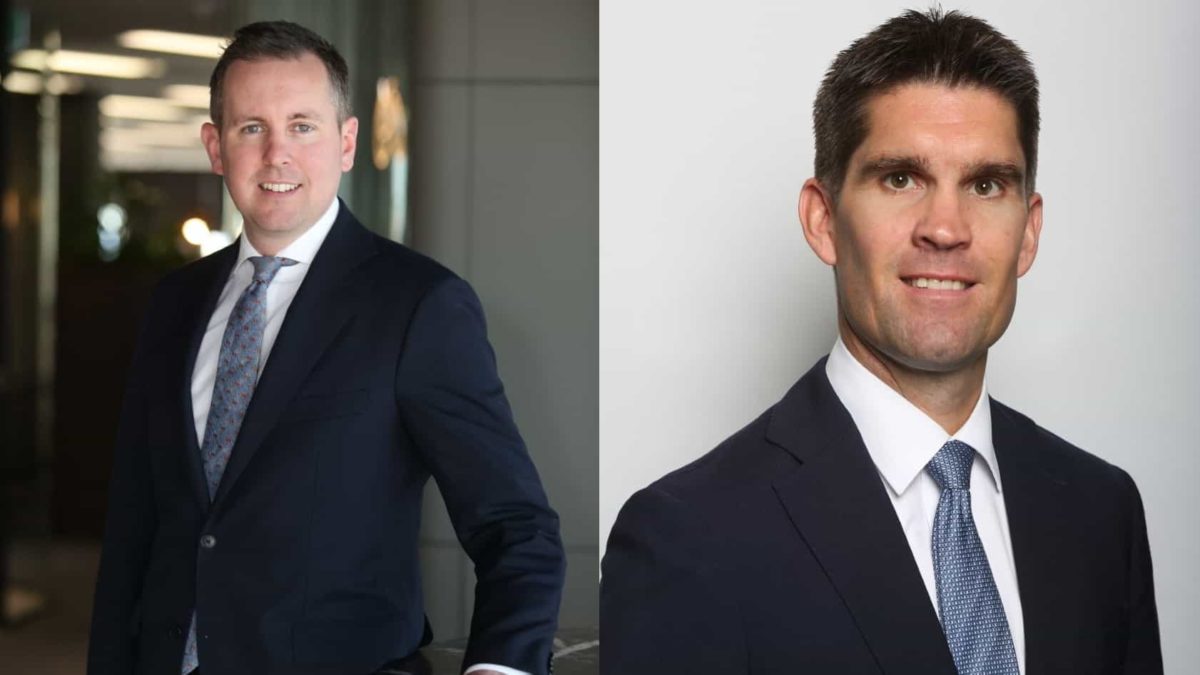Fancy a 52.7% annualised return over the past 3 years?
How about a 75.7% return over the past year?
Me too! Which led the Motley Fool to reach out to Stuart Wilton and Ross Lees over at Centuria Capital Group (ASX: CNI).
Ross is the head of funds management for Centuria Capital and Stuart is the fund manager for Centuria's ATP Fund. That's the fund that delivered the returns I just quoted above, as at 30 June.
We'll get to what they shared with me in a tick. But first…
A bit of background
Centuria's business is focused on both unlisted and listed Australian real estate investment trust (REIT) property funds as well as investment bonds. As at 30 June, Centuria had $9.4 billion of assets under management (AUM).
Centuria's ATP Fund (which stands for Australian Technology Park) commenced in 2016. The unlisted fund, no longer open to new funds, has 100% ownership of three commercial office buildings totalling 19,800sq m in South Eveleigh, a thriving business hub in New South Wales.
Centuria's two listed property trusts are the Centuria Industrial REIT (ASX: CIP) — included in the S&P/ASX 200 Index (ASX: XJO) — and the Centuria Office REIT (ASX: COF), which is part of the S&P/ASX 300 Index (ASX: XKO). You can buy and sell shares in these REITs just as you would any other shares on the ASX.
As at 5 August, CIP's 53 industrial assets were worth $2.1 billion. COF's 23 office assets were also worth $2.1 billion.
Both A-REITs were performing well until the COVID-19 panic selling hit the share markets.
In the 12 months up to 21 February 2020, the Centuria Office REIT's share price gained 33%. The share price then tumbled 55% through to 23 March and has since regained 40%. Year to date, COF's share price is still down 30% as investors worry about potential lingering impacts to the office market. A topic Ross Lee addresses below. COF pays an 8.6% annual dividend yield, unfranked.
As you'd expect, the Centuria Industrial REIT's share price has been a stronger performer in the post-COVID world. In the 12 months through to 21 February, the A-REIT gained 30%. The pandemic saw the share price fall 39% from there through to 23 March. Since then it's rebounded 39%, leaving the share price down 5% year to date. CIP pays a 5.9% annual dividend yield, unfranked.
Read on for the insights Stuart Wilton and Ross Lees provide on investing in Australia's listed and unlisted commercial real estate markets.
What would you say are the primary advantages and disadvantages of investing in unlisted property funds, versus listed property funds?
Ross: People have to think about their own circumstances. But the pros of an unlisted property fund are that people can identify the building they're investing in. They're not tied to a portfolio of assets. They can look, feel and touch the particular building. We'll typically have a strategy that is designed around that building itself. For how we're going to acquire it, how we're going to manage it and how we're going to exit it.
One of the primary issues people face investing in an unlisted fund is liquidity. Once you've invested in the asset, we typically hold it for a period of at least 5 years. So investors need to hold onto the fact that their money won't be redeemable during that period. The money will be returned upon sale of the asset and completion of the business plan.
The other consideration is whether investors prefer or don't prefer diversification. Being invested in a single building you get the outcome that goes with that building. Where in a pooled product, like listed assets, there'll be a suite of buildings you'll be invested into. And the outcomes are less reliant on the performance of one building rather than the suite of buildings.
On the listed side, the pricing is determined by the market, not necessarily the asset value. There are times when REITs will trade at a price above the net tangible asset value and other times where they'll be below the net tangible asset value. That's part of the volatility that goes along with investing in listed equities. In the listed market you do have the liquidity of having a T+2 liquidity event. [Being able to sell your shares for cash in 2 days.]
Are there different metrics you use when investing in assets for your REITs compared to your unlisted funds?
Ross: For the types of assets that our company invests in, there's not a significant divergence in the assets there. We consistently look for high quality buildings, decentralised locations, and quality tenants. Effectively buildings we believe have the underlying attributes to continue to pay reliable and predictable dividends and distributions to unit-holders in those funds, regardless of whether they're listed or unlisted.
Ultimately, we focus on asset quality. A number of our buildings are very much underpinned by the tenant quality. Close to 40% of our overall portfolio across all of these funds have leases to state and federal governments. High quality rent payers with predictability of income is paramount.
The locations are usually determined by access to great infrastructure. So rail connectivity, road connectivity, and then retail amenities as well. A lot of these funds are office-centric. It's really about making an investment decision that's aligned with worker happiness that goes to long-term attraction for tenants.
Stuart: And it doesn't have to be existing infrastructure. It can also be planned infrastructure. We try to identify those districts that are going to benefit from future investment from government or the private sector.
With some of our recent funds that was quite evident with the city metro coming in. Like the Zenith fund up in Chatswood. We do place a lot of emphasis on the infrastructure component, particularly looking to the future, and that could also involve alternative uses that we can evaluate too.
Do you ever dispose of assets before the 5-year term expires?
Stuart: Typically, the funds are 5-year terms with an ability to extend. So, they're fixed-term, closed-end funds on the unlisted side. There is a business plan, which we generate at the start of that acquisition. Where that business plan has been met and it makes sense to realise an asset, whether that's during the 5-year fund term or at the end, we will assess the situation and make a recommendation to our investors.
So, yes, we may divest assets at varying times throughout that 5-year term, although the primary aim is to provide an attractive income yield across the duration of the fund term. We've also extended some fund terms following the 5-year initial term expiry. It's ultimately dependent on where we think the asset is relative to its business plan, factoring in current market conditions.
Over the 20-year history of Centuria we have wound up 44 unlisted funds worth about $2.2 billion. Our average annual return on those funds is around 16.8% per annum.
What distinguishes Centuria Capital from some of your competitors in the listed and unlisted real estate markets?
Ross: As a company we're very much hands-on property managers. We undertake all of the leasing ourselves, property management, facilities management. We're very focused on how we use our skills and expertise to drive the repositioning of buildings and effectively maximise value and create that point of liquidity into the future.
Stuart: That's one of our key competitive advantages that we see happening. We do have this fully integrated funds management business with an in-house asset management team that is quite proactive and hands on. We see we can implement some strategies that maybe others cannot.
Getting back to the ATP Fund, how did you achieve 3-year returns of 52.7% and a 1-year return of 75.7%?
Stuart: It's been a combination of rental growth as well as CAP-rate compression. [CAP-rate compression is when investors believe prices in rising markets will keep rising and pay more with those future expectations in mind.]
It goes back to our initial investment within that park back in December 2013. Our investment rationale at the time was to invest in this precinct because it's relatively close to Sydney's CBD, just one stop from the central station. It was an emerging location for technology and innovation companies plus it had the potential for further development. Rents at the time were only about $450 per square metre gross, which was very cheap compared to the CBD. Now we've recently completed transactions of $910 per square metre gross. Rents have essentially doubled over that time. The park was owned by the government initially. It was put on the market via a tender. We joined Mirvac in a Mirvac led consortium, which was the successful bidder to acquire the park for $263 million in 2016.
Mirvac brought along a 93,000 square metre pre-commitment from the Commonwealth Bank of Australia for their new metropolitan headquarters, along with a significant amount of additional retail and $25 million of public domain works to improve the facilities. Combined with the strength of Sydney's commercial office market that resulted in extremely good rental growth as well as CAP-rate compression.
Ross: We took a position in there on attractive terms and saw the opportunity to really drive rental growth through active strategies.
How has COVID impacted you and your tenants, and what actions have you been taking to address that?
Ross: What we did to respond to that is that we had real time data coming through. What our tenants were doing throughout the buildings, how our tenants were performing, their ability to pay rent and what we needed to do, or if we needed to help certain tenants.
Up until 30 June, right across the platforms — office, industrial and healthcare — we generated rental collections in excess of 90%. So there was an impact, we want that to be 100%. But we run $7 billion of commercial real estate across the 3 sectors, so having over 90% coming in was a really solid statistic. We've focused on making sure that the buildings are in a situation where tenants feel comfortable returning to work. Priorities have been making safe work plans, places where people want to come.
The next part of the strategy is how we look at workplaces of the future. How might they evolve and how we deliver fit-outs for tenants. We believe that does lead to a push towards more decentralised locations as long as they're well serviced by critical infrastructure. That does represent a strong opportunity.
We also look at what industries may be affected, ones that may be in decline as a result of this and also which industries might actually accelerate. We've seen, obviously, a huge acceleration in e-commerce. The industrial sector already had a big tailwind behind it, and that's just really pushed it along. In the last 2 months we've been the largest acquirer of industrial real estate in Australia.
There are a number of REITs trading on the ASX. What sets the Centuria Office REIT and the Centuria Industrial REIT apart?
Ross: A key differentiator with the industrial REIT is that it's the only pure play REIT exposed to the industrial sector in Australia. Our fund is there to provide investors with exposure to quality industrial logistics assets in Australia. We don't do business parks, we don't do derivatives of industrial. It's 100% core exposure to industrial. There's no other vehicle on the ASX that provides that.
The office REIT is almost a mirror image but in the office sector. It's a pure play REIT with exposure to Australian offices. What differentiates us is the scale of this portfolio and the quality of assets that sit in it. We've been acquiring very significant metropolitan style assets, great tenants, great quality buildings that we believe can provide that reliable and ongoing income to our investors.
Quality only really matters when you get tested. We've been through an event in the past 6 months. And for these portfolios to be generating the kinds of returns they have been, with 90% rental collections, that really is the proof of the quality of the assets and the underlying tenants.
Looking ahead, what are the risks and opportunities for investors in Australia's office and industrial markets?
Ross: The risk for industrial is the market is easy to supply. You can construct new supply in 12-18 months. It's a market that has a significant amount of capital that wants to invest into it at the moment. Strong investor appetite will lead people into potentially speculative construction, which does have the chance to impact the supply of buildings into the market.
For us, we tend to invest in markets that are actually difficult to add supply to, that is, they are in established, often infill markets that are located near to key infrastructure nodes and population centres.
The opportunity in industrial is the revolution in e-commerce, how companies respond to it, what they do in their supply chains and how that can drive industrial demand.
Within the office sector there are really 2 markets, inside the CBD and outside. There is supply coming onto the markets in the Sydney and Melbourne CBDs. Is the demand environment as strong in the CBDs as what we thought 2 years ago? It's difficult to say demand is as strong.
For us the opportunity is how do you respond to this challenge ahead? How do you create workplaces that people want to come to, to really differentiate ourselves in the current market?
People are buying real estate because they want income. Interest rates have gone down. If you can get the right real estate with good quality tenants, I think you're really well positioned into the next couple of years.









